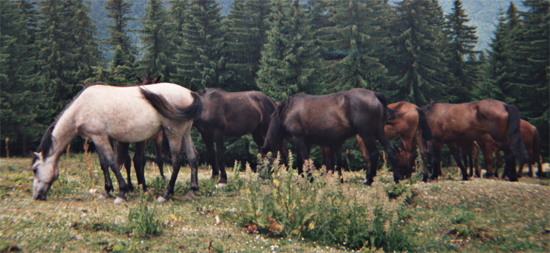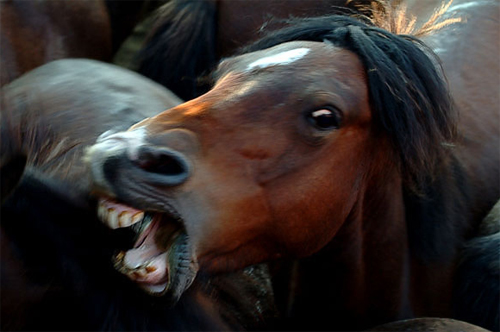As Luperci adopt and adapt former human technologies, Luperci domestication of other animals has arisen. European Luperci societies, which have developed faster than the rest of the Luperci world, learned horse domestication stories and techniques from former working dogs. From there, horse domestication has slowly spread to ‘Souls, along with other advanced Luperci technologies.
Horses make things easier when it comes to transportation, especially as Luperci become less “wild” and accumulate all kinds of things they want to haul around. Horses are also fun companions that can make your character’s life more interesting and add to your roleplaying experience. However, horses aren’t just a prop, and players should educate themselves about them to ensure realistic treatment in roleplay!
Basic Considerations
Why a Horse?
Although horses have become popular at ‘Souls in recent years, they’re far from a necessity for everyone, and it’s important to consider the reasons your character might want a horse, and whether they’d benefit from having one. After all, horses require a lot more specialized care and maintenance than the average pet or companion!
Benefits to Owning a Horse
- They’re a means of personal transportation
- They’re a way to transport goods
- They are a valuable and typically easy-to-trade asset
- They can make good companions
Downsides to Owning a Horse
- Typically necessitates the ownership of tack and other items
- Horses can be difficult to provide food for, especially for those without access to a large amount of secured territory
- Horses can be difficult and time-consuming to train/may not get along with their owners
- Horses are easily stolen or poached
Weight Limits
In general, horses can carry up to 20% of their body weight without adverse effects. Adult horses range from 840 to 2,200 pounds depending on species and breed. The average riding horse is around 1,250 pounds, so it’s important to keep in mind your character’s weight when choosing a horse.
Luperci that exceed 200 pounds will need to be extra mindful about finding a mount that can support its weight. It’s also important to keep in mind that tack and other equipment or goods add to the weight a horse must carry. For example, a western saddle can add 30 or more pounds to a horse’s burden.
In the real world, many stables set a hard limit of 250 pounds for riders. At ‘Souls, we do not have a hard limit, especially since Luperci themselves may not be aware of a healthy limit, but horses that are overburdened should be realistically played — that is, they would be crippled quickly if forced to carry over their limit regularly or for a long period of time.
Travel Limits
Horses can make travel easier by providing a way to haul lots of goods and supplies, but they don’t necessarily make travel any faster.
It’s generally recommended to ride a horse just 20 miles a day at a comfortable trot. Most horses can only go at a gallop for about 2 miles before fatiguing. At both paces, going longer is possible, especially depending on the type of horse, but driving a horse too hard will lead quickly to exhaustion and injury.
Meanwhile, a wolf in Lupus form can travel 30-40 miles a day at a comfortable trot, and can travel 50 or more miles if needed. As predators, canines specifically evolved to have more endurance than the prey they pursue! That said, Luperci who prefer Optime form or who have a lot to carry will go significantly slower, and for them, a horse might be the more practical option.
Choosing a Horse
Horses are social herd animals, and herd dynamics are not so different from wolf pack dynamics. A pecking order exists within established herds, and any new horse that is introduced may cause infighting, especially if the newcomer has a dominant personality. As with wolves, horse combat is rarely bloody or fatal. Such confrontations of dominance usually end in a simple stand-off, with one animal acquiescing control to the other without physical confrontation.
Sex
The sex of your horse is a large factor in how it behaves. Stallions tend toward more aggressive behavior, and mares are usually calmer, though this does not mean all mares are docile and stallions are vicious.
Stallions
A single stallion tends to the herd: it is his job to live on the outskirts of the herd and defend the herd from predators, alerting his mares to any dangers. Excepting during the mating season, the stallion’s behavior around his herd is usually relaxed, tending towards “relaxed guard” rather than acting aggressively. Stallions sometimes tolerate an unrelated younger male rival within his herd, though the younger stallion will eventually succeed him.
Stallions are naturally dominant and are generally considered to be more aggressive and difficult to handle than mares — some will attempt to dominate inexperienced riders. Stallions tend to have a heavier musculature and thicker neck than mares or geldings.
Gelding (castrating) a stallion can make for a more even-tempered, easy-to-handle animal, but it may not be as effective if done later in a stallion’s life. The decision to geld should be made before the horse’s third birthday.
Mares
The dominant mare is the actual “leader” of a herd: she is generally an older animal, and she decides the herd’s direction, locations for grazing, traveling routes, and so forth. Mares are common for beginner horsemen as they are usually calmer and are more receptive to training. However, mares, while less aggressive, will not hesitate to also show their place in the pecking order by kicking and biting if they feel challenged by a newcomer.
Age
Foals and yearlings cannot be ridden as a horse’s bones develop slowly and the stress of carrying extra weight will adversely affect them. The vast majority of horses are not ridden until they are three years of age, and riding them too young can lead to irreparable damage to health.
Obtaining a Horse
Wild Capture
Horses travel in bands or herds together, and their numbers provide protection. Wolves and other canines are typically seen as predators, and a Luperci will not be able to stroll merrily into the midst of a herd and rope up a horse. It takes some dedication and hard work to catch a wild horse solo, and it’s far more common for a small group of Luperci to round up one or more wild horses into large pens as a means of capture.
Trading
If the right deal can be struck, your character may trade for a horse from a variety of sources. Remember that horses are valuable assets though — you won’t be able to trade away a few small trinkets and expect to get a healthy horse in exchange!
Packs
Some ‘Souls packs raise horses, so your character might be able to obtain a horse by bartering. Many packs provide inventory lists that note which characters own which horse. Try posting in the Thread Requests forum asking for someone to help you out — alternatively, you can Private Message the pack’s leadership.
Outside of ‘Souls
Another option is to trade in the Portland area. The journey to Portland isn’t terribly long, but those territories are outside of ‘Souls playable areas, and you’ll have to engage in some time play to make the journey plausible, but it’s certainly doable!
Breeds
Though horse breeds are as unique and diverse as the domestic dog, the post-apocalyptic world is not a place where they will all survive, much like dog breeds. Hardy, medium-sized animals that stand the most chance of surviving, much like dogs. Huge, muscular horses require more food in order to survive, and small, tiny horses would be more likely to be viewed as prey animals by Luperci and other predators.
Nova Scotia Natives
Sable Island Pony

Most horses found within Nova Scotia would be of the Sable Island Pony type, some even of the very same breed. The Sable Island Pony is a landrace, and it is likely any horses of domestic or feral origin in Nova Scotia would evolve to similar states as the Sable Island pony without selective breeding.
Although the Sable Island Pony is referred to as a pony, it has a horse phenotype, and is classified as a horse rather than a pony. The Sable Island pony typically weighs about 360 kg (794 lbs) for males and 300 kg (661 lbs) for females. These horses are found primarily to the southern points of Nova Scotia, originating from Sable Island.
In 1979, the population stood at 359, and at its lowest in 1980, there were 158 horses. In 1985, there were approximately 350 wild horses living on the island. It is safe to say their numbers were at a similar state in 1988 when human populations were decimated, as the horses were declared protected in 1960, and human interference with their populations was minimal.
Others
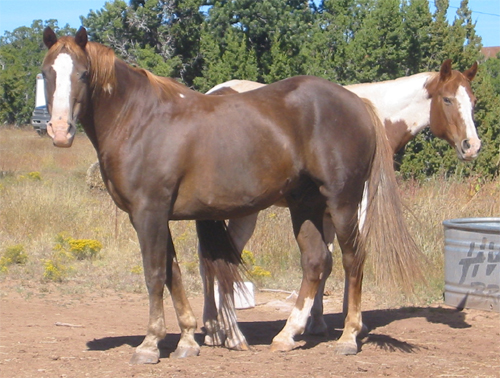
Nova Scotia was home to a few breeding farms, stables, and innumerable farming/personal horses prior to the extinction of humanity, however; feral horses descended from these domestic animals and not of the Sable Island Pony breed can be found within ‘Souls.
It is important to evaluate the likelihood of surviving breeds: even hybrids of rarer types of horses such as the Orientals (excepting the Arabian) or the Baroque horses would be extremely unlikely in Nova Scotia, while overall popular breeds — the Gypsy Vanner, the Thoroughbred, Quarter Horses, etc. — would be more commonplace.
Note, however, that finding an identifiably purebred horse is unlikely, and Luperci would be guessing (at best) when it comes to the determination of that horse’s breed. The horses captured within Nova Scotia (i.e., not bred) are generally grade horses — remember that horses don’t have any sort of inclination to preserve their breed and heritage as Luperci might have, and will interbreed quite willingly. It is therefore likely the horses encountered in the wild will be of a certain type but not necessarily a certain breed.
Breed Survivability
Much like the domestic dog guide, here we are grouping certain horses of similar characteristics together and evaluating the likelihood of the type surviving. When investigating a particular breed of horse, it’s important to do further research as to just how commonplace that horse was. Very common horses to a particular area might have become dominant, leaving behind something very close to the human breeds.
Likely Types
- Feral horses such as the Banker horse, Mustang, Brumby, are very likely to have survived: they were in existence prior to humanity’s extinction, and it’s extremely likely surrounding horse populations ended up looking like their feral counterparts.
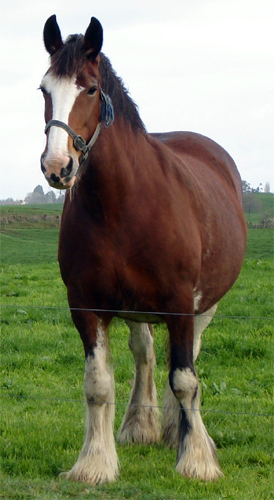
- Baroque horses, such as the Lipizzaner, Friesian, Andalusian, and Lusitano, are heavily muscled but powerful and agile. They are likely breeds to be cultivated by the Luperci, though these horses would not be as commonplace as some other horse types.
- Stock horses such as the Arabian horse, Mustang, Morgan horse, Quarter Horse crosses, are riding horses characterized by agility, quickness, and powerful hindquarters. They would be commonplace in the Americas, and quite likely a common capture for horse wranglers, especially in the midwest.
- Draft horses such as Percherons, Belgians, Shires, and Clydesdales, are typically large horses bred for hard, heavy tasks such as ploughing and farm labour. They would be sought after by Luperci, who would value their large stature and heavy carrying capacity.
- Cob horses such as Gypsy Vanner Horses and Welsh Cobs, are horses generally stout build, with strong bones, and large joints. Though they are smaller horses, they were commonplace during the time of humanity, often used for showing and dressage, and they would likely be cultivated by the Luperci for cart work and similar pulling duties.
- Gaited horses such as American Saddlebreds, Tennessee Walkers, and Missouri Foxtrotters are horses that have natural gaited tendencies, that is, the ability to perform one of the smooth to ride, intermediate speed four-beat horse gaits, collectively referred to as ambling gaits. They are extremely popular breeds.
- Oriental horses are the ancient breeds of horses developed in the Middle East, such as the Arabian, Akhal-Teke, Barb. They tend to be thin-skinned, long-legged, slim in build and more physically refined than other types, but with great endurance. The Arabian was a popular breed in the time of the humans, and influenced various breeds of horses over the years.
Unlikely Types
- Heavy warmbloods such as the Ostfriesen, Alt-Oldenburg, Groningen Horse, and Gerlander are the ancestors of the modern warmbloods, and are typically bred by preservation groups to fit the pre-World War model of the all-purpose utility horse. However, most of these breeds were rare, with closed studbooks (a stud book or breed registry that does not accept any outside blood) — these animals were something a rarity, likely absorbed into other horse populations.
- Wild horses are a special consideration. Note that there is a difference between a wild horse and a feral horse: a feral horse is a horse that was formerly domesticated, but now roams wild. A wild horse was never domesticated in the first place. The only remaining wild horse is the Prezwalski’s horse, which is extremely unlikely to be kept as pets — extremely rare and nearly extinct in the wild in 1988, their survival to this day is unknown. They are also not an ancestor to the modern horse. Additionally, non-domesticated Equus species — such as the zebra, onager, or kiang asses — are prohibited due to their rarity and lack of domestication.
- Ponies and small breeds of horse would be of little use to Luperci — they would be viewed as prey animals, more likely than not! It’s not impossible for a Luperci to own a pet pony, but it’s unlikely, and very small ponies would not be useful for working purposes.
Selective Breeding
Luperci are capable of selectively breeding horses, much like humans prior to the 1988 apocalypse. In Europe, formerly domesticated dogs passed some horsemanship knowledge along, and it is very likely these dogs would also seek to preserve breeds of particular use or appeal. Draft horses, like the Percheron, Belgian, Shire and Clydesdale, are capable of carrying heavy loads, and were likely to be cultivated carefully.
Several prominent families in the UK and France practice breeding of Shire, Clydesdale, Friesian, Gypsy Vanner, Percheron, and Belgian horses. Smaller, lighter horse breeds can be found throughout Spain and the Mediterranean, along with many more breeders. In the Americas, the port of Freetown serves as a trading post where several unique horse breeds can be found. The southwestern United States are likely to have many horses, as well.
Do note though, that horses have longer lifespans than Luperci. They mature more slowly, have longer gestation periods, and have fewer young. As such, it is highly unlikely that Luperci have been able to breed many successive generations of horses in the time since 1988.
Horse Coloration
Horses are often described by color before they are described by breed. Purebred horses are rare, and most Luperci would not have verification that horses of similar description to human books are actually descended of that particular breed.
Basic Colors

Wikipedia provides an extensive list of horse coat colors here. The most basic ones are:
- Bay: The body color ranges from a light reddish-brown to very dark brown with “black points” on the mane, tail, and lower legs.
- Chestnut: A reddish body color with no black; the mane and tail are the same shade or lighter than the body coat.
- Gray: A horse with black skin but white or mixed dark and white hairs. A gray horse is distinguished from a white horse by dark skin, particularly noticeable around the eyes, muzzle, flanks, and other areas of thin or no hair.
The vast range of all other coat colors are created by additional genes action upon one of these three coat colors. For example: a palomino horse is a chestnut horse with one cream dilution gene; a cremello horse is a chestnut horse with two cream dilution genes. Both have the same base coat color with different genes acting upon it to produce a variation of the base color.
Note that the gene for true albinism does not exist in horses.
Communication
Speech?
As you may know from the Speech Guide, horses are animals that communicate in low speech. High speech is beyond a horse’s capabilities. Horses are prey animals, and they aren’t nearly as smart as Luperci. As a result, advanced anthropomorphization — such as organized horse societies and communication of in-depth ideas and concepts between horses or horses and Luperci — is not possible. That being said, a Luperci capable of communicating in low speech with a horse would have a far easier time as a horse owner!
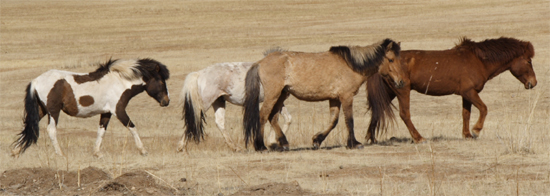
Noises
- Exhaling: A soft sigh usually indicates a relaxed or relaxing horse, perhaps after a threat has passed. It can also be a simple sign of contentment. Half-closing the horse’s eyes is also a sign of contentment.
- Sharp snorts: Sharp snorts are either a sign of alarm or a clearing of dust from the nostrils. If it is the former case, the horse’s body will tense and its ears will lay back, along with a stiffening of the lower lip to indicate clear alarm.
- Deep, vibrating snorts: Long, deep snorts that vibrate from the horse’s chest are a sign of extreme alarm: a horse making this noise may spook shortly.
- Whinnies and neighs: This high pitched sound that falls in pitch as it continues is loud and is a general sound and is used as a call for contact with herd members, a warning of danger, or a sound of need.
- Screams: A scream is similar to a neigh or whinny but louder and more intense: it is a sound of fear, often given by a lost foal or separated horse. It is also heard during fighting.
- Nickering: This soft chortling noise is one that mares often give as a greeting to their offspring. This noise can also be a greeting for a Luperci, especially when it is meal time.
- Grunting: Horses grunt when they exert themselves, such as during rolling or when they are bucking or rearing.
- Squealing: Horses usually squeal when interacting with other horses. The short, excited call can mean that they are interested in playing with the horse. If paired with signs of aggression or fear, it is a call for the other horse to leave them alone and get away.
Training
All horses intended to be anything more than a simple companion must be trained. Horses have personalities just like people (and Luperci). Some are skittish and difficult to train, while others are immovably calm and easy to train. Still, even calm, trained horses may be wary of canines they do not know and can even spook at unfamiliar situations.
Additionally, horses require more training of a more intense variety if they are to be used for purposes such as warfare, hunting, etc. It isn’t natural for a horse to charge into the thick of battle — it’s noisy and it smells like blood and fear, which is not something a prey animal such as a horse wants to experience. Obviously, it takes even more time and dedication to train a horse for these specialized pursuits.
Even when trained, most horses will still test boundaries, at least mildly, and some horses with dominant personalities will openly challenge a weak or inexperienced handler. For example, if handled with incompetence or abuse, a horse may ignore its training and attempt to nip, bite, kick, refuse to be led, or try other ways to challenge dominance. Even if a horse was previously owned and trained, a new horse must become accustomed to its new owner.
Wild versus Domestic
Feral animals must be taught to respect Luperci as the dominant member of the herd, and they must also understand that Luperci have no intention of causing harm. This can be very difficult to teach a wild horse. It generally takes a fair amount of work for a captured feral horse to become accustomed to canine presences. One method that might work especially well for a horse to become used to Luperci is the Rarey technique — as this place the horse in a position of absolute submission to the Luperci, where the horse’s very life is in the canine’s hands, it might be a good technique to utilize.
It is easier to train a horse that was raised around Luperci (i.e., a domesticated horse). Newly foaled horses should be introduced to the presence of canines early on so they recognize them as non-threatening; handling and contact during the earliest weeks of life is extremely important toward facilitating later-life training. Like most animals, a young horse will more easily adapt to unnatural expectations than an older one, so handling of the horse from a very early age is generally advised.
Breaking a Horse
No horse is born knowing how to accept commands from a rider. The initial goal of training is to create a horse that is safe for Luperci to handle (under most circumstances) and able to perform a beneficial task. A horse is not ready to be ridden until it is accustomed to all riding equipment and is responsive to basic voice and rein commands to start, stop, turn and change gaits. Attempting to ride a horse that is not ready to be ridden can result in severe consequences. Humans have died from being bucked off a horse and Luperci face similar dangers!
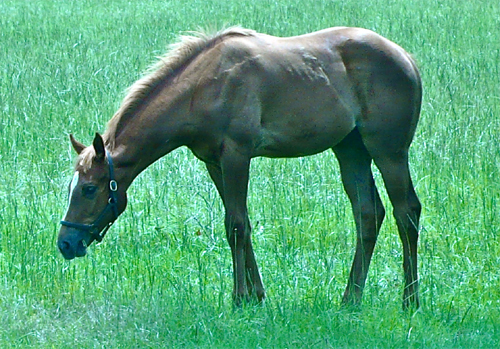
Proper Age for Breaking
The age that horses are first ridden varies considerably by breed and discipline: race horses have small, light riders on their backs as early as the fall of their yearling year, whereas most stock horses are ridden by the age of two. Harness horses generally have a cart first put behind them at age two.
However, the vast majority of horses across disciplines and throughout the world are first ridden at the age of three.
Breaking Steps
Breaking a horse involves weeks of work. Each of these steps will require a few days (or a few weeks, if your horse is of particularly surly temperament). It is not recommended for your character to rush through training, as this can result in an ill-mannered, difficult-to-control animal.
Quickly breaking a horse like in a rodeo — stuffing the horse into a chute and riding the buck out of the animal — is possible and it does work, but this method is extremely dangerous for both the Luperci and the horse in question. Additionally, even if rodeo-style breaking teaches the horse to accept a saddle and rider, the horse still must undergo more training, such as how to accept commands from a rider.
For younger animals, it is a good idea to start them with the basic procedures years before they are ready to ride. The foal can be lead-broken (trained to accept a halter and a lead rope) when it is only a few weeks old. Note, however, that younger animals possess less attention span and patience for work; it isn’t a good idea to train a very young horse for more than twenty minutes to a half hour per day.
- The horse must become accustomed to wearing a bridle and other tack equipment. The horse should be allowed to smell the objects and inspect them before use. Touching and handling the horse while it wears these things are essential to teach the horse that the objects pose no threat.
- The horse learns to move away from pressure: this can be accomplished by poking the horse in the shoulder or side until it moves away, ceasing the poking immediately.
- A light saddle pad or blanket on the horse’s back will accustom the animal to pressure on its back. When the horse is alright with this, the saddle can be introduced, though it should be cinched very loosely at first, stirrups drawn up in case the horse bucks. When the horse accepts the cinched saddle, the rider should place their hands into the stirrups and pull down slightly to introduce the horse to the idea of pressure on its back.
- Mount the horse slowly: the rider should place one foot in the stirrup and lean their weight into it, before swinging the other leg over. If the horse moves away, start over again. When the horse is comfortable with a seated rider, repeatedly mounting and dismounting the horse accustoms it to the procedure. If the rider is not using a saddle, lay your upper body(chest) over the horse to see how they react to the weight before mounting.
- Get the horse to move by gently squeezing the legs together. Once the horse begins walking, the rider must teach it to turn by squeezing the opposite side the horse is intended to turn and pulling the reign into the turn. Stopping is accomplished by leaning back in the saddle and gently pulling back on the reins.
Types of Training
Voice Commands
- A word, such as the name of the horse, or simply a word like “and…” should be used as a “half-halt,” essentially to warn the horse that a command is coming. For example, to ask for walk to trot transition, one would say “and trot.”
- A word other than whoa should be reserved to calm a horse (such as “easy” or “steady”), This word should be spoken in a low tone and calm manner.
- A word for praise (such as “good boy”) should be used frequently whenever the horse responds correctly to a command.
- “QUIT!” should be spoken in a displeased tone when the horse misbehaves (such as he begins kicking). It should be said sharply right when a horse is not compliant. The word “no” should be avoided, as it sounds very similar to “whoa.”
- A trainer may cluck or make another type of chirping or kissing sound to increase speed or impulsion. It is best to cluck when the inside hind leg begins to move forward. Overuse of voice to encourage impulsion will cause a horse to ignore the trainer.
There are various types of specialized training. A horse that knows how to carry a rider does not necessarily know how to pull a cart; each skill must be taught to the particular horse. Additionally, some forms of training take years of studious discipline for the horse to master.
Trading for horses fully broken in these advanced styles will be far more expensive than trading for a basic riding horse or even an unbroken horse. Simple, basic training can easily triple the bartering price for a horse — advanced disciplines will make for a very costly animal.
- Herding/Ranching: Horses must be made used to the idea of wrangling a large group of animals, but this doesn’t take a ton of extra training, as the majority of herding and ranching is simply riding the horse in the direction your character wants to go. Western-styled riding is useful for herding and ranching purposes — the horse is generally trained to respond to light rein commands and leg pressures, leaving at least one hand free for the rider to utilize a lasso or other herding tool.
- Driving: Hitching equines to a wagon, carriage, cart, sleigh, or other horse-drawn vehicle by means of a harness and working them in this way requires added training. Voice commands may be especially important for horses that are used to drive carts and wagons. Horses can be driven in teams, though this requires a different sort of vehicle and often requires additional training. However, initial training of a young horse with an older, experienced horse can ease training for the younger animal.
- Charging/Warring: The horse must be made used to all manner of strange things, loud noises, crowds, and so on and so forth. A horse that does not have experience and training in this area is just as likely to buck and throw their rider. “Whether horses were trained to pull chariots, to be ridden as light or heavy cavalry, or to carry the armoured knight, much training was required to overcome the horse’s natural instinct to flee from noise, the smell of blood, and the confusion of combat.” A ridden war horse was trained with limited use of reins, responding primarily to leg pressure and the voice — this frees the rider’s hands for combat.
- Racing: Prior to their fourth birthday, the skeletal system of the horse has not developed completely, and there is greater potential for catastrophic injury if they are raced before their fourth year. Running and racing a horse before this point can result in a lamed horse. Racing-styled training is not very useful for Luperci, but some may race horses for pleasure.
- Dressage: This form of training has a fundamental purpose to develop a horse’s natural athletic ability and willingness to perform, maximizing its potential as a riding horse. Light, minimal tack is used: this type of training often requires many years to perfect. Few Luperci will find the complex movements useful to teach their horses, but some basic training incorporated from this style of riding may be useful for some horses
General Care
Feeding
To maintain a healthy weight, a horse will generally consume about 2 to 5 pounds (0.9 to 2.3 kg) of grain and 15 to 20 pounds (6.8 to 9.0 kg) of hay a day — on top of whatever they eat while grazing. Grain is difficult to come across for Luperci unless they are also experienced in farming techniques. Apples are readily available and can be substituted for a substantial part of the diet; additionally, some species of native grass can be used to make hay. Horses also require plenty of water.
Unless an animal can be fully maintained on pasture with a natural open water source, horses must be fed daily. As horses evolved as continuous grazers, it is better to feed small amounts of grain throughout the day than to feed a large amount of grain at one time. An average of between one and 3 acres (12,000 meters squared) of land per horse will provide adequate forage in much of the world, though feed may have to be supplemented in winter or during periods of drought.
Grooming
Grooming a horse is relatively simple and allows the handler to check for injuries. Additionally, grooming is a good way to gain the trust of the animal; many types of grooming are pleasurable for the horse. Any dirt must be removed before tack can be put on or the risk of chaffing and ringworm rises greatly. The mane and tail can be brushed like hair, though this is not required on a regular basis. Bathing does not need to be a regular part of grooming.
Medical Concerns
Horses are prone to a variety of medical concerns, including, but not limited to:
- Parasite infestation — commonly, botflies, roundworms, and other intestinal parasites.
- Colic — A general term for abdominal pain. There are many causes for such pain, ranging from the mild and inconsequential to the life-threatening or fatal.
- Laminitis — Serious lameness of the hooves. The horses hooves are hot, painful, and the horse has difficulty moving or standing.
- Thrush — An infection in the horse’s hooves caused by improper hoof management.
As Luperci lack advanced medical technology, some of these conditions prove to be extremely difficult to treat. It is therefore in a horse owner’s best interest to engage in preventative care and try to stop these injuries and illnesses before they occur. The inexperienced horse owner is likely to make mistakes in the horse’s care, easily resulting in a dead horse!
Leg Injury
Leg injuries are perhaps among the worst conditions that can occur to a horse; even those that are not immediately fatal still may be life-threatening because a horse’s weight must be distributed evenly on all four legs to prevent circulatory problems, laminitis, and other infections. If a horse loses the use of one leg temporarily, there is risk to the other legs during the recovery period. While horses periodically lie down for brief periods of time, a horse cannot remain lying in the equivalent of a human’s “bed rest” because of the risk of developing sores, internal damage, and congestion.
Hoof Care & Shoeing
In human times, all domesticated horses need regular hoof trims, regardless of their work use. Horses in the wild do not need hoof trims because they travel large distances on a daily basis to search of forage, a process that wears their feet naturally. Domestic horses in light use are not usually subjected to such severe living conditions, and when the horse is not worked, their feet grow faster than they wear down. Without regular trimming, their feet can get too long, eventually splitting, chipping and cracking, which can lead to lameness.
Many Luperci, especially those belonging to packs, allow their horses to roam territories when not in use. Depending on how an individual horse is kept, it may or may not require hoof trimming.
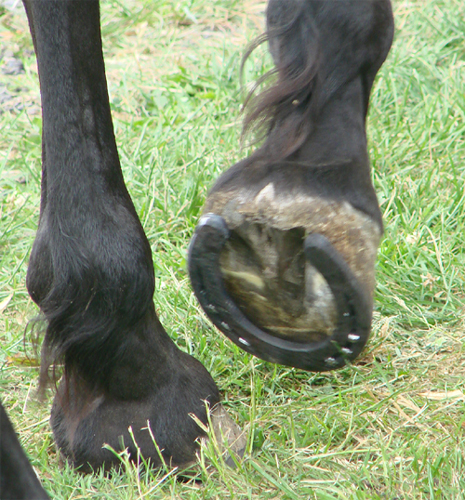
On the flip side, many forms of work wear down a horse’s hooves faster than the horse can grow them, which requires that the horse wears shoes. The added weight of a rider or strain of pulling a cart necessitates shoes, especially with consideration to heavy Luperci. While “barefoot horses” were somewhat common during the time of humans, few Luperci are light enough for this.
Many horseshoes were made of metal and would have survived the apocalypse: however, depending on the material, some would be unusable and others would require reworking. A titanium horseshoe, strong and extremely stable, would easily survive the apocalypse, but these would be a rarity in comparison to rusty iron horseshoes.
Shoeing, when performed correctly, causes no pain to the animal. Farriers trim the insensitive part of the hoof, which is the same area into which they drive the nails. Even a skilled farrier makes mistakes, especially if the horse moves during the shoeing process.
As an alternative to shoeing the horse, one might hipposandal or “boot” the horse. Rawhide and leather are more readily available to Luperci than scavenged horseshoes, and leatherworking is a far more common skill than metalworking!
Psychological Care
Horses are prone to what are called “stable vices” if they are kept confined for too long a period of time with improper exercise. Keeping a horse in a tiny stall can cause undue stress and boredom to the horse. Horses should be exercised regularly and turned out to pasture as often as possible to minimize the occurrence of stable vices.
Common forms of stable vice that are particularly insidious include cribbing, a behavior where the horse grabs a board or other surface with its teeth, arches its neck, and sucks in air. This can harm the teeth and may lead to colic. Weaving and circling are repetitive movements that may cause lameness if left untreated.
Solutions to these problems when a horse cannot be let out to roam a pasture for a while (e.g., in the case of long-term injury) can be solved by placing a smaller companion animal in the horse’s stall — donkeys, goats, and even cats have been successfully utilized previously. However, the best solution is to simply allow the horse out to browse and exercise for some time each day.
Tack
Bridle
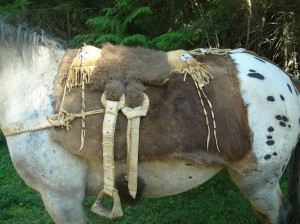
A bridle goes around the horse’s head and includes a piece called a bit. The bit commonly sits in the dental gap of the horse’s mouth (not between their teeth as sometimes thought). The reins are attached to the bit, and they are generally the means of controlling a horse.
Alternatively, a hackamore is a headgear that utilizes a heavy noseband of some sort, rather than a bit, most often used to train young horses or to go easy on an older horse’s mouth. Like bitted bridles, noseband-based designs can be gentle or harsh, depending on the hands of the rider. It is a myth that a bit is cruel and a hackamore is gentler.
Saddle
A saddle is a leather seat made to fit over the horse’s back and tighten around their belly, to make riding more comfortable. Depending on the type of work a horse is intended to do, a different type of saddle should be used: for example, ranching work often requires a deep-seated saddle to provide maximum stability for the rider.
As well-made saddles can be difficult to come by in North America, some riders may opt to ride bareback. This does, however, restrict their ability to carry any supplies and requires a lot more skill on the rider’s part. More primitive saddles, or simple seats, can be made with blankets and furs, as well.
Luperci-made Tack
While some human-made tack may have been found in usable condition early in Luperci history, it’s unlikely that any remain. As such, a majority of tack available are Luperci-made, and far less sophisticated than human-made tack.
Leather and leatherworking aren’t uncommon resources or skills among more advanced Luperci, but metal and metalworking are. Most Luperci-made saddles, harnesses, and bridles would use rope to secure and fasten different straps, rather than metal. Leather bitted bridles and hackamores are also far more common than metal bitted bridles.
Other Mounts & Beasts of Burden
Native Animals
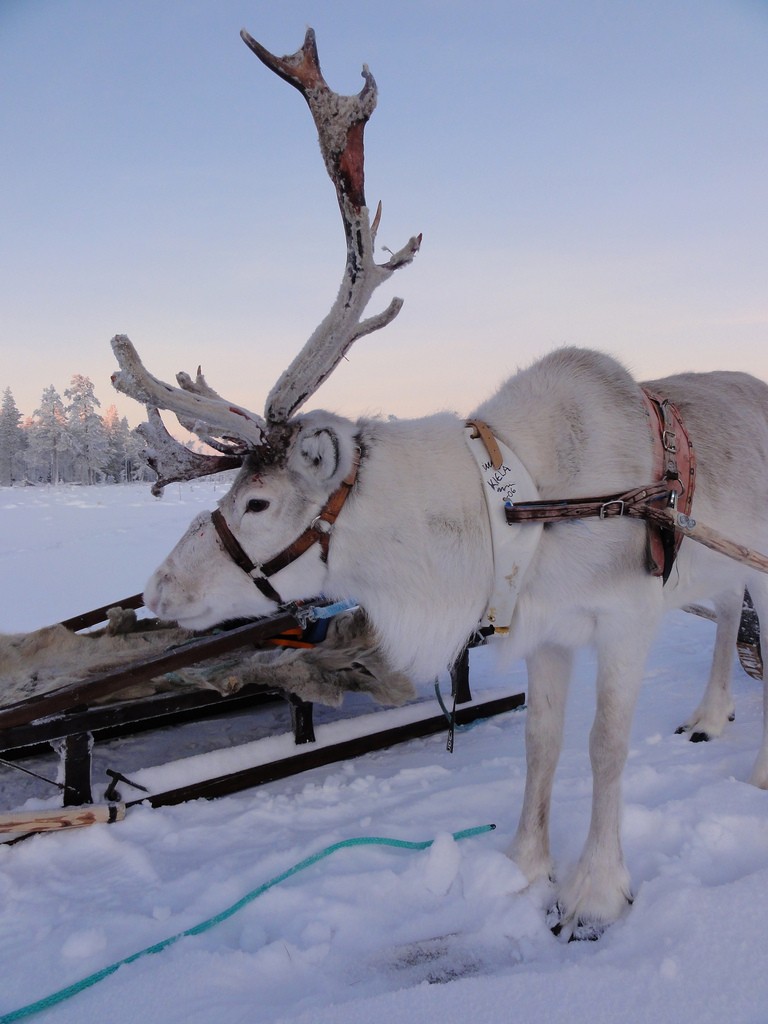
Other animals have been used at ‘Souls for purposes similar to horses include donkeys, reindeer, and elk. In addition to being found in and around Canada, these species have previously been domesticated, or at least been proven trainable by humans, so they’re more feasible and realistic than, say, a white-tailed deer — which would make for an extremely flighty pack animal that can’t even carry that much.
While these species are allowed, it’s important to keep in mind that reindeer and elk do not have a long history of domestication and were not specifically bred for carrying heavy loads like horses are and may experience back problems or injuries from carrying too much. (Compare the weight of an average elk with that of an average horse and an average Luperci!)
If you’re uncertain about whether your use of a non-horse beast of burden is realistic or feasible (or even if your use of a horse is!), please feel free to submit a realism check request.
Exotic Animals
Still more exotic beasts of burden can be found elsewhere in the world — e.g., some canines in Asia may use Asian Elephants for labor, transportation, and leisure, just as humans did. When considering any species, however, realism is always important. Elephants are not native to North America, and specimens from North American zoos would have died without human care. It’s impossible for a Luperci to get an elephant from across the world to ‘Souls — it just isn’t feasible with the sailing technology and the expense of keeping such an animal alive for the journey.
For the most part, exotic beasts of burden are permissible in character histories, if your character hails from an appropriate part of the world, but elephants, camels, yaks, and other non-native beasts of burden shouldn’t be making their way to ‘Souls.
